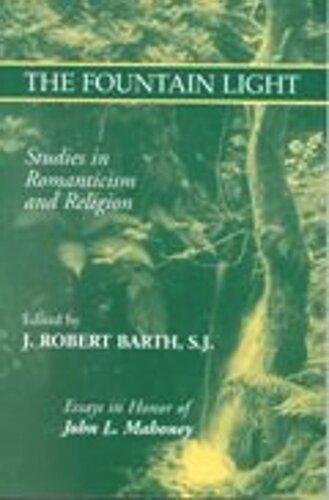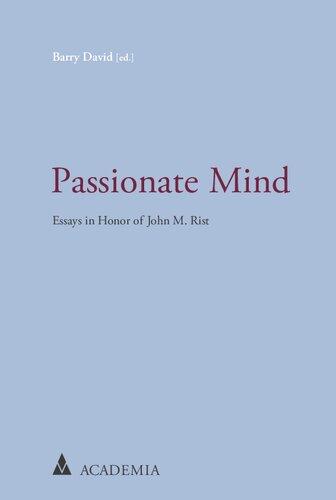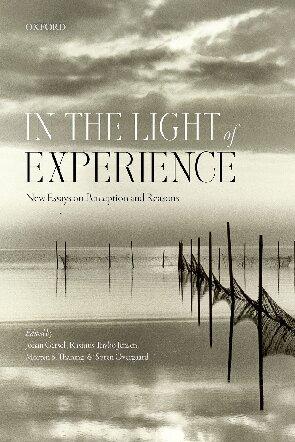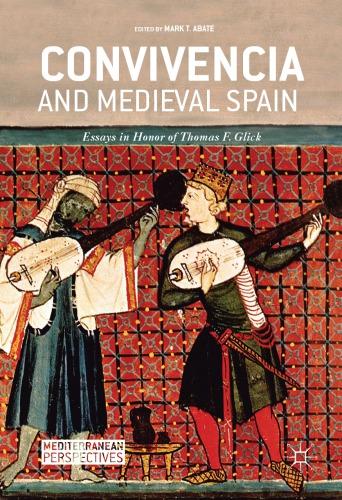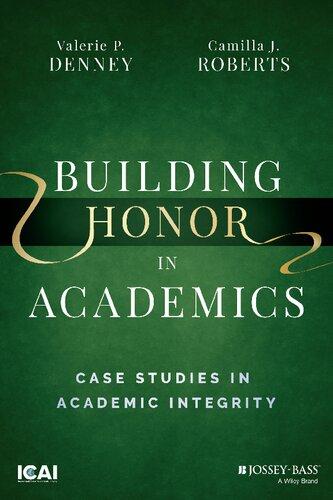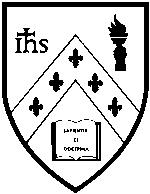JOHNL.MAHONEY
AProfile
Perhapsthephotograph thefrontispieceofthisbook saysitbetter thanmywordscan.Thereheis theintentlook,theeloquenthands, thewarmandinvitingsmile allattheserviceofthestudentswhosit beforehim.JohnMahoneyisnowheremorehimself,somewouldsay, thanwhenheisintheclassroom.Andintheclassroomheisasmuch alistenerasheisatalker,forheisinvariablyintentnotonhimself,nor evenprimarilyonhisstudents,butontheideasandimagesandwords that flowbetweenthem.NoonebutJohnwassurprisedwhen,several yearsago,hewasnamedMassachusettsProfessoroftheYear.
Auniversityfriendandcolleague,BenBirnbaum,wroteofJohnMahoneyinanelegantandeloquentarticleinthe BostonCollegeMagazine: ‘‘Evenwhilelistening,heappearstobecoveringground,thoughtand emotionplayingacrosshislong,expressivefacelikelandscapeonthe windowsofamovingtrain.’’ Intheclassroom,hegoeson, ‘‘thisattentiveenergyworkslikeagravitationalcore,drawingstudentthoughts andideas,which,amplifiedbytheprofessor’sglosses,correctionsand punctuationmarks,arethenshotbackacrosstheroomtobeinscribed asfulllecturenotesinstudentnotebooks.’’
Birnbaum’scommentaryonJohn’sclassroomperformanceishardto resist,soIpresumetoquoteitagain.Johnhadtoldhisstudentsabout ajazzrecordingwhichhefoundhe ‘‘onlylikedafterseveralhearings.’’ However,hewenton, ‘‘whenyoubreakthroughthecomplexity,you seemtoseethisluminousorder.’’ ThiswasinBirnbaum’smindwhen heattendedanotherofJohn’sclasses ‘‘andwatchedhimworkhis charms.’’‘‘ Whatweretheytakenwith?’’ hewonderedofthestudents. ‘‘Isitthetweed-wrappedauthority?Thelearning?Theconsideration withwhichhegreetseachandeveryremarkhecansqueezeoutof them?Thepassionofhisreadings?Oristheresomethingmorethatis responsibleforhisextraordinarycharismaasateacher somethinghe representstostudentsthatisrarelytobefoundinpostmodernculture
xii
APROFILE
orpostmodernclassrooms:perhapsthatveryold-fashionedandmost uncynicalpossibilityof finding(givenluckandwill)the ‘luminous order’ behindtheconfusion;thatpossibilityofanearnedwholeness?’’
Butthis ‘‘wholeness’’ inJohnMahoney’slifeisacomplexreality perhapslikethecomplexityofthatjazzrecording.Oneofhissons remarkedofJohnthathehasa ‘‘desireforanddelightinallthings beautiful.’’ Anyonewhoknowshimwillappreciatethatthisissimply theveriesttruth.Hisloveofliterature ineveryoneofitsforms is legendaryandinfectious,hisdevotiontothetheatreisalifelongpassion,hisloveandknowledgeof filmisdeepandpassionate,andheis aseriousandknowledgeablejazzafficionado.Theverymentionof,say, StevieSmithorSeamusHeaney,aproductionofTomStoppard’s Arcadia attheHuntingtonTheatreorarecent filmofDavidLynch’s,ajazz recordingbyBillEvansorMarianMcPartland,willsethimoffona wonderfulrifforanintenseexchange.Justtryhimon MyDinnerwith Andre ´ ,oneofhisfavorite films andprepareforatreat!
AstudentofseveralyearsagorecallsJohnMahoney’sclasson My DinnerwithAndre ´ asastrikingexampleofhis ‘‘deepdramaticsensibility.’’ Thecoursewas ‘‘ ThePoetryofReligiousExperience,’’ andJohn enteredtheclassandintroducedhimselfasAndre ´ Gregory.Foran hour,he was Andre ´ Gregory,thestudentrememberswithsomething approachingawe. ‘‘Neveroncedidhebreakcharacter,’’ andbytheend ofthehourhisstudents ‘‘felttheyhadmetAndre ´ Gregory.’’
This ‘‘dramaticsensibility’’ isalsocelebratedinaremembranceofa youngJesuitwhotookacoursewithJohnintheHarvardUniversity SummerSchoolsomeyearsagoon ‘‘Eighteenth-andNineteenth-CenturyLiteraryCriticism. ‘‘Amongthememorablemomentsofthe course, ’’ herecalls, ‘‘werehisimpersonationsofSamuelJohnson,which broughttheoldcritictolifeforus.’’ Heseemed,hegoeson, ‘‘tohave memorizedhalfofJohnson’sjuiciestcriticalmaxims,whichhewould recitewithJohnsoniangusto.’’
Perhapsitshouldcomeasnosurprisethatthesonofaprintershould besopassionateaboutwords:thewrittenword thepoetryofWordsworth,thesonorousproseofDr.Johnson;orthespokenword in conversation,intheclassroom,in filmoronstage.Butitwasalong journeythattookthissonofaprinterfromtheblue-collarneighborhoodofhischildhoodinSomerville,Massachusetts,toHarvardUniversityinnext-doorCambridge.ThejourneywasbywayofaJesuit education, firstatBostonCollegeHighSchool,thenatitssisterschool,
BostonCollege.Inlocalparlancethatmakeshim referringtothe mascotofboththeseinstitutions a ‘‘doubleeagle.’’ Severalyearsof serviceinthepostwarU.S.Armyfollowed,afterwhichhereturnedto thebanksoftheCharlesRiverforhisdoctoralstudies.
AtHarvardtheaspiringscholarmetsuchliterarygiantsasDouglas Bush,PerryMiller,B.J.Whiting,AlfredHarbage,HerschelBaker andWalterJacksonBate.ItwasW.J.Bateinparticularwhowasto becomeinmanywaysamodelforhisownscholarlycareer.Theyboth beganworkintheliteratureoftheeighteenthcentury,onlytomove oninthecourseoftheircareerstobecomerespectedcriticsofthe Romanticperiod.Andfortherestofhislife,W.J.BateandJohn Mahoneyweretoremainnotonlyclosecolleaguesoneithersideofthe Charles,butclosefriends.
EventhemostcursorylookatJohnMahoney’slengthybibliography makesitclearthathisintellectualrootsareintheeighteenthcentury. Hisvery firstpublishedarticlewason ‘‘ TheClassicalTraditionin Eighteenth-CenturyRhetoricalEducation,’’ bringingtogether one mightsurmise hisJesuitrhetoricaltrainingandhiseighteenth-centurystudiesatHarvard;andhis firstpublishedbookwasaneditionof the EssayonOriginalGenius oftheeighteenth-centuryScottishcritic WilliamDuff.But,likethoseofW.J.Bate,John’sinterestsweretoo broadtobeconfinedtotheeighteenthcentury,andhesoonbeganto publishonRomanticism hisinterestculminatinginhislearnedanthology TheEnglishRomantics:MajorPoetryandCriticalTheory,publishedovertwentyyearsagoandstillinusetoday.Therefollowedhis majorbookonHazlitt, TheLogicofPassion:TheLiteraryCriticismof WilliamHazlitt;anothermajoranthology,stillinuse,on TheEnlightenmentandEnglishLiterature; abookontragedy;and finally spanning bothhismajor fieldsofscholarship hiswide-rangingstudy, TheWhole InternalUniverse:ImitationandtheNewDefenseofPoetryinBritish CriticismandAesthetics,1660–1830. Otherworkfollowed,inbooksand scholarlyjournals,leadingtohisrecentimportantbooksonWordsworth: first,hissplendid WilliamWordsworth:APoeticLife, whichfollowsinthetraditionofcriticalbiographypioneeredbyBate;andhis mostrecentbook, WordsworthandtheCritics:TheDevelopmentofa CriticalReputation. Andthereis,ofcourse,promiseofmoretocome. Besidesthesheerrangeofhisscholarship,though,oneisimpressed bywhatIcanonlycallthe ‘‘ openness ’’ ofJohn’slearning.Schooledin
anearliertraditionofliterarywork,heisalwaysopentofreshcurrents ofideasandnewmethodologies.Heisinvariablyalerttotheworkof youngercolleagues,forexample,andisnurturedbytheirapproachesto literatureeven orperhapsespecially whentheydifferconsiderably fromhisown.Ashewrote,memorably,intheintroductiontohis splendidbook WilliamWordsworth:APoeticLife, ‘‘whilemyowntemperamentcannotbedescribedasdeconstructive,Ihavelearnedvaluable lessonsabouttheheuristicandpleasurablepossibilitiesofseeingvaried andoftenconflictingmeaningsinthetextasinthelargertextofhuman experience’’ (p.xxiii).ForJohn,methodologies whatevertheymay be arealwaysinserviceofthepoetryandthepoet.Ashesaidin outlininghisapproachtoWordsworth’s ‘‘poeticlife’’: ‘‘Ilookforan approach,onethateschewsmerechronology,easycategories,andfacile generalizationsasittriestoconnectlifeandworkmoreclosely,to developawayofthinkingaboutthelifeasitnourishestheworkand theworkasitilluminatesthelife’’ (xxi).InJohnMahoney’swork,asin hislife, ‘‘ openness ’’ and ‘‘wholeness’’ areinextricablylinked.
Asanyoneisawarewhoknowshim,JohnMahoney’sgifts evenbeyondteachingandscholarship aremanyandvaried.Heservedfor severalyearswithgreatsuccessasdepartmentChair,forexample,and hisleadershiponmajorcollegeanduniversitycommitteeshasbeen frequentandhighlyrespected.Thefacultyluncheonshehasregularly organizedforthepastseveralyearshaveaddressedsubstantiveissues concerningthenatureofaJesuitandCatholicuniversity issueshe holdsdearandonwhichhespeakswithbotheloquenceandauthority. Givenhiswell-knownandhighlyregardedleadershipabilityandorganizationalskills,therehavebeenattemptstolurehimintofull-time academicadministration,butJohn’shearthasalwaysbeenintheclassroomandwithhisscholarlywork.Anditwassurelyinrecognitionnot onlyofhisteachingandscholarshipbutalsoofallhisvariedgiftsthat in1994JohnwasnamedtotheThomasP.RattiganChairofEnglish, the firstendowedprofessorshipinthehistoryoftheDepartmentof EnglishatBostonCollege.
‘‘Attentiveenergy,’’ wasthephraseBenBirnbaumusedofJohnMahoney.Andthisisperhapsaphrasethatcouldbeusedtocharacterize everyaspectofhislifeandwork:histeaching,hisscholarship,his ‘‘universitycitizenship,’’ hisremarkablegiftforfriendship,hisbeautifulde-
votiontoAnnandhisfamily.John’swholelife,Isuggest,ismarkedby thisquality,for asBirnbaumputsit—‘‘anindefatigableinterestinthe livesofothersisahallmarkofhissensibility.’’ Whetheritbehisbelovedfamily,hisfortunatestudents,orsuchseeminglyfar-off figures asDr.JohnsonandWilliamWordsworth,hebringstothemallhis ‘‘attentiveenergy,’’ his ‘‘indefatigableinterestinthelivesofothers’’— andhislove.Inreturn,we,hiscolleagues,students,andfriends,offer him onbehalfofsomanymorewholoveandrespecthim thistributeofouradmirationandaffection.
J.R.B.
ReligionandAnimalRights intheRomanticEra
DavidPerkins
,insignificantastheyappearinyourestimation,weremadebyGodaswellasyou....Howthencanyouexpect thatGodwillsendHisblessinguponyouif,insteadofendeavouringto imitatehiminbeingmercifultotheutmostofyourpower,youare wantonlycrueltoinnocentcreatureswhichhedesignedforhappiness.’’1 SoinSarahTrimmer’s TheRobins (1786)Mrs.Bensonreproves MissLucyJenkins,avisitingten-year-oldwhohadneglectedtofeed someyoungbirds chickswickedlytakenfromtheirnestsbyher brother.Mrs.Benson’sremarkswerecommonplaces.Similarpoints weremadeoverandoverintreatises,sermons,pamphlets,poems,and literatureforchildrensuchasTrimmer’sverypopularbook.Butinno otheragewouldtheseideashaveseemedsoobvious forexample,that animalsareinnocent,thatGoddesignedthemforhappiness,andthat Hewillpunishcrueltytothem.
Sympathy,compassion,andfellowfeelingwithandforanimalshad beenvoicedrecurrentlyfromHomerthroughtheages.Moralistshad generally,thoughnotinvariably,condemnedcrueltytoanimalsasdangerous,becauseofthepassionsstirred,bothforthepersonwhoinflicts itandultimatelyforsociety.ButinEnglandaround1775sympathyfor animalsbegantobeexpressedwithfargreaterfrequencyandemotional commitment.Argumentswerebroughtforwardthathadbeenless availableorhadseemedlessconvincinginthepast.Thebearersofthis increasingsolicitudeweremostlytobefoundinthe15%to25%of thepopulationthatmightbecalledmiddleclass.2 Thewriterswho
1 SarahTrimmer, TheRobins,or,FabulousHistories,DesignedfortheInstructionof ChildrenRespectingTheirTreatmentofAnimals (Boston,1822)69 –70.
2 Ontheproportionofthetotalpopulationthatmightbeconsideredmiddleclass,
THEFOUNTAINLIGHT
propagateditweremiddle-classintellectuals preachers,poets,philosophers,andthelike.
Theyencounteredresistancefromthestart,weredismissedas cranks,disturbers,molly-coddlers,effeminates,andradicals.Forexample,a1772sermonbyJamesGrangeronProverbs12:10, ‘‘Arighteous manregardeththelifeofhisbeast,’’ washeardwith ‘‘almostuniversal disgust.’’3 HumphreyPrimattknewin1776thathewasexposinghimselfto ‘‘obloquy’’ bypublishinghis TheDutyofMercyandSinofCruelty toBeasts. 4 Whenin1796JamesPlumptre,inspiredbyCowper’s The Task,preachedbeforetheUniversityofCambridge,inthepresenceof PrinceWilliamofGloucester,on ‘‘ TheDutiesofMantotheBrute Creation,’’‘‘thesubjectwasthenconsideredbymanyastrifling,and beneaththedignityofthepulpit,andespeciallythatoftheUniversity.’’5 Astimepassed,however,thehearersandreadersofthisdiscourseincreasinglyshareditsviewsandemotions.Animalsbecamea humanitariancauselikeslaves,prisoners,chimneysweeps,foundlings, andotherhelplessvictims,andtheefforthascontinuedeversince.6 We nowrefertoallsuchpleasandpoliticalactivityonbehalfofanimals withthecoveringterm ‘‘animalrights.’’ Twohundredyearsagothere
seeLeonoreDavidoffandCatherineHall, FamilyFortunes:MenandWomenofthe EnglishMiddleClass,1780 –1850 (London,1987)23 –24.
3 AnApologyfortheBruteCreation,or,AbuseofAnimalsCensured;inaSermonon Proverbsxii10,2nded.(London,1773)27.
4 QuotedinRichardD.Ryder, AnimalRevolution (Oxford,1989)67.
5 ThreeDiscoursesontheCaseoftheAnimalCreationandtheDutiesofMantoThem (London,1816)v.
6 Onthiseighteenth-centurydevelopmentseeKeithThomas, ManandtheNatural World:ChangingAttitudesinEngland,1500 –1800 (London,1983)36 –192.ThefollowingbooksdealmainlywithVictorianandmoderndevelopments,buthavesome preliminarymaterialonearlierperiods:ErnestS.Turner, AllHeaveninaRage (New York,1965);HarrietRitvo, TheAnimalEstate:TheEnglishandOtherCreaturesinthe VictorianAge (Cambridge,Mass.,1987);JamesTurner, ReckoningwiththeBeast:Animals,Pain,andHumilityintheVictorianMind (Baltimore,1980);HildaKean, Animal Rights:PoliticalandSocialChangeinBritainsince1800 (London,1998).Discussions ofpoemsonthistopicincludeDixHarwood, LoveforAnimalsandHowItDeveloped inGreatBritain (NewYork,1928)andDagobertDeLevie, TheModernIdeaofthe PreventionofCrueltytoAnimals (NewYork,1947).Ihavewrittenonthecomplex relationofcertainpoetsandpoemstothecampaignonbehalfofanimals: ‘‘Cowper’s Hares,’’ EighteenthCenturyLife 20(1996):57– 69; ‘‘ WordsworthandthePolemic againstHunting: ‘Hart-leapWell,’’’ Nineteenth-CenturyLiterature 52(1998):421–445; ‘‘CompassionforAnimalsandRadicalPolitics:Coleridge’s ‘ ToaYoungAss,’’’ ELH 65(1998):929 – 944; ‘‘SweetHelpston!JohnClareonBadgerBaiting,’’ Studies inRomanticism 38(1999):387– 407; ‘‘AnimalRightsand ‘AuguriesofInnocence,’’’ BlakeQuarterly 33(1999):4 –11.
RELIGIONANDANIMALRIGHTSINTHEROMANTICERA 3 werealsoclaimsthatanimalshadnaturalrightsandshouldbegranted legalones.ButthoughIadoptourcontemporarytermforitsshorthand convenience,myfocusisthegrowinginsistencethatanimalsoughtto betreatedkindlywhethertheyhaverightsornot.
Thesourcesofthischangingattitudelieamongculturalandsocial developmentsfamiliartoallstudentsoftheperiod:sentimentalism;the redescriptionofmoralgoodnesstoemphasizesympathyandkindness; theidealizationofexternalnature,ofwhichanimalsareapart;scientificdiscovery(partlythroughvivisection!)thatthehigheranimals closelyresemblehumansintheirphysiologyandhenceprobablyalso tosomeextentintheirthoughtprocessesandpassions;agrowingmiddleclassthatwaslivingintownsorcitiesandwasnotdirectlyinvolved infarmingor financiallydependentonit;thesense,withinthissocial group,ofemergingfromaGothicpastintomoderncivilizationand refinement,sothatthegruesomeblood-sportsofthegentryandthe bull-baitingsandcock-throwingsofthepopulaceseemedatavistic ‘‘barbarian’’ wasthecommontermforcrueltiestoanimals;thespread inallclassesofpetkeeping,withtheresultthatanimalswereseenas individuals,eachwithitslifehistory,andonthemwereprojected humanmotivesandcharacteristics.Perhapsalsoatthistimeagreater modernsensitivitytopainbegantoemergeandafeelingthatitis anomalous.Certainly,theUtilitarianequationofpainwithevilsurfaces inthemostsurprisingplaces,forexampleinMaryWollstonecraft’s OriginalStoriesfromRealLife (1791),abookforchildren. ‘‘Doyou knowthemeaningofthewordGoodness?’’ asksMrs.MasonofMary, agefourteen,whohasbeenchasinginsects. ‘‘Iwilltellyou.Itis, first, toavoidhurtinganything;andthen,tocontrivetogiveasmuchpleasureasyoucan.’’7
Twohundredyearsagoargumentsaboutanimalrightsreferredhabituallytoreligion.This,infact,isthemoststrikingdifferenceinthe debatesthenandnow,forotherwisethepointsmadethenweresimilar toours,proandcon.ByreligionIdonotmeanthechurches,for althoughindividualclergymenspokeout,thevariouschurchesand sectsdidnottakeapositiononanimalrights.Thenearestthingtoan exceptionmightbefoundinMethodism;Wesleyimpressedonhis preacherskindnesstoanimalsasaconcern.8
7 OriginalStoriesfromRealLife (1791;facsimileOxfordandNewYork,1990)5.
8 RichardE.Brantley, Locke,Wesley,andtheMethodofEnglishRomanticism (Gainesville,1984)90.
THEFOUNTAINLIGHT
TheBible,thedictatedorinspiredwordofGod,wasalsomute.It was,ofcourse,theultimatesourceofreligiousauthorityformostmiddle-classpersons,andwascombedforinstructiononhowtotreatanimals.Butthemanypertinenttextswerenotharmonious;moreover, theyweresubjecttovaryinginterpretations.Whoeverwishestoknow justwhichpassagescouldbecitedcanrefertothesermonbyJames Plumptrementionedearlier,whichtakesupalmostallofthem.UndeniablyGodhadgivenmandominionovertheanimals(Genesis1:26), buttherewasnothingtosuggestthathumansshouldbeharshoruncaring.Afterthe floodHehadmadehiscovenantnotonlywithNoah butwiththeanimalsalso(Genesis9:12),andthissurelyimpliedHis concernforthem.TherewereregulationsinDeuteronomy(22:4,6) thatenjoinedkindnesstocattleandtonestingbirds;Balaam’sass (Numbers22:21–34)hadseentheangelwhenBalaamcouldnot:Job (17:14)hadsaid ‘‘totheworm,Thouartmymother,andmysister.’’ Andsoforth.
Asanexampleoftheearnestnessandingenuitybroughttobearin interpreting,wemayviewWilliamPaley’swrestlingwiththevegetarianquestion:isitrightforhumanstoeatanimals?Meateatingwas oftennumberedamongtheconsequencesofOriginalSin,anideathat innowayincreasedpleasureatdinner.Godhadcertainlyauthorized ourfeedingonanimals(Genesis9:3),butthishadnotbeenuntilafter the flood,anditwasnolesscertain,asPaleyreadhisBible,thatman inparadisehadlivedonlyonvegetables(Genesis1:29).Mightgreens bepreferableinGod’seyes?ThusPaleywasinterestedinknowing whattheantediluviansate,thosepersonswhohadlivedbetweenthe Fallandthe flood,and,sofarastheBibleinformsus,hadnotyetbeen givenpermissiontoeatanimals. ‘‘ Whethertheyactuallyrefrainedfrom the fleshofanimals,isanotherquestion.Abel,weread,wasakeeper ofsheep;andwhatpurposehekeptthemfor,buttoeat,ishardtosay (unlessitweresacrifices):mightnot,however,someofthestrictersects amongthem[theantediluvians]bescrupulous,astothispoint;and mightnotNoahandhisfamilybeofthisdescription;foritisnot probablethatGodwouldpublishapermission,toauthoriseapractice whichhadneverbeendisputed?’’9 Thus,inferencefromtextscouldnot inspireconviction.OnecouldnotplausiblyciteBalaam’sass,or Christ’sridinganassintoJerusalem(Mark11:1–7),orevenhisbirth inastable,toeduceGod’sviewsonkindnesstocattle.
9 ThePrinciplesofMoralandPoliticalPhilosophy,2vols.(London,1785;reprintNew York,1978)84.
RELIGIONANDANIMALRIGHTSINTHEROMANTICERA 5
ItwasnotfromtheBible,then,thatSarahTrimmer,inthesentencesIquotedatthestart,derivedherpremisesandherconfidencein them.Soalsowiththegreatmanyotherwriterswhomademoreor lessthesamepointsinthesameway,thatis,ina ‘‘potted’’ fashion, briefly,withoutargument,asonestatesthegenerallyknownandaccepted.Forexample,ThomasPaine,in TheAgeofReason (1793),says that ‘‘themoraldutyofmanconsistsinimitatingthemoralgoodness andbeneficenceofGod,manifestedinthecreationtowardallHis creatures ...everythingofcrueltytoanimals,isaviolationofmoral duty’’;10 ThomasYoung,in AnEssayonHumanitytoAnimals (1798): ‘‘ TheCreatorwillsthehappinessofthesehiscreatures,andconsequentlythathumanitytowardsthemisagreeabletohim,andcruelty thecontrary’’; 11 EdwardAugustusKendallin Keeper’sTravelsinSearch ofHisMaster (1799),averypopularstoryforchildren:menshould ‘‘acknowledgetheRights;insteadofbestowingtheirCompassionupon thecreatures,whom,withthemselves,Godmade,andmadetobe happy’’;12 Wordsworthin ‘‘Hart-LeapWell’’ onthedeathofahunted deer:
ThisbeastnotunobservedbyNaturefell; Hisdeathwasmournedbysympathydivine.
TheBeing,thatisinthecloudsandair, Thatisinthegreenleavesamongthegroves, Maintainsadeepandreverentialcare Fortheunoffendingcreatureswhomheloves. 13
Clearlythefamous ‘‘moral’’ ofColeridge’s ‘‘ TheRimeoftheAncient Mariner’’ (1798)wasnotunusualinitstime:
Heprayethbest,wholovethbest Allthingsbothgreatandsmall; ForthedearGodwholovethus, Hemadeandlovethall.14
10 TheAgeofReason (1794),ed.P.S.Foner(Secaucus,N.J.,1974)98.
11 QuotedinSamuelF.Pickering,Jr., JohnLockeandChildren’sBooksinEighteenthCenturyEngland (Knoxville,1981)37.
12 Keeper’sTravelsinSearchofHisMaster (1799;Philadelphia,1801)v.
13 WilliamWordsworth, ‘‘Hart-LeapWell,’’ lines163 –168,in EnglishRomantic Writers,ed.DavidPerkins,2nded.(FortWorth,1995)322.
14 SamuelTaylorColeridge, ‘‘ TheRimeoftheAncientMariner,’’ lines614 – 617,in ThePortableColeridge,ed.I.A.Richards(NewYork,1950)104 –105.
THEFOUNTAINLIGHT
IfGodintendedthatanimalsshouldbehappy,itfollowedthatcruelty tothemwasimpious.Personswhourgedkindnesstoanimalsdidnot typicallybelieveinaGodofwrathandvengeance,butHewasjust. ‘‘Manmaydismisscompassionfromhisheart,/ButGodwillnever,’’ Cowperwrotein TheTask (1785),andwhoevershowednomercyto animalswouldhimself ‘‘seekit,andnot findit.’’15 Sometimesthisrhetoricbecamealarming.Blake’sThelknew ‘‘ ThatGodwouldlovea Worm...andpunishtheevilfoot/Thatwilfulbruis’ditshelpless form,’’ andthereisBlake’smuch-quotedcoupletin ‘‘AuguriesofInnocence ’’ : ‘‘ARobinRedbreastinaCage/PutsallHeaveninaRage.’’16
WehavelearnedtoreadspecialmeaningsintoBlake’swords,but shouldnotignoretheliteralthreat.In TheRightsofAnimalsandMan’s ObligationtoTreatThemwithHumanity (1838),WilliamDrummond waxedterrifying: ‘‘toinjure,toabuse,tomaim,torture,orinflictupon them[animals]anypainwhichcanbeavoided,istoactinopposition tothewillofHeaven,andriseinrebellionagainsthisMaker,’’ thesin ofSatan.17
ThattheFatherloves all Hiscreaturesandintendsthemtobehappy wasthemostpowerfulandusualargumentoftheRomanticage.Ifyou believedit,thatis,ifyouacceptedthedescriptionofGod’sbeingand attributesthatliesbehindit,andtheinferencesfromthisdescription, itstoodinthewayofhunting,baiting,whipping,driving,cramming, plucking,andinnumerableotherpractices,painfultoanimals,that wereanordinary,familiarpartoflife.Intheboxingtermsoftheera, theargumentwasnota ‘‘settler,’’ foryoucouldclaimthatthesepracticeswerenecessary,or,alternatively,thatlivegeese,forexample,do notmindhavingtheirquillsplucked defensesthatarestillusual but atleasttheargumentwasa ‘‘facer.’’ Itmadeyoupauseandthink.The burdenofproofhadnowshiftedtoyou.
ThedescriptionofGodthatgroundsthisargumentistoofamiliar toberehearsedatlength.Intheeighteenthcenturyanunfathomable, fearfulGod,whoincalculablybyHisgracesavessomepersonsandnot others,seemedincredibletomanyEnglishintellectuals.Asabeing
15 WilliamCowper, TheTask,BookVI, ‘‘ TheWinterWalkatNoon,’’ PoeticalWorks, 2vols.(London,1830),II,176,181.
16 WilliamBlake, ‘‘ TheBookofThel,’’ Plate5,lines9 –10; ‘‘AuguriesofInnocence,’’ lines5– 6,CompleteWritings,ed.GeoffreyKeynes(London,1966)130,431.
17 TheRightsofAnimalsandMan’sObligationtoTreatThemwithHumanity (London,1836)49.
RELIGIONANDANIMALRIGHTSINTHEROMANTICERA 7 perfectlygood,Godmustwishthehappinessofallbeings,sincethisis intrinsictowhatwemeanbygoodness.Somuchcouldbeknown a priori.AsThomasReidtoldhisstudentsattheUniversityofEdinburgh, ‘‘Goodness,Mercy&forbearanceareevidentlyimpliedina perfectmoralcharacter,forwithoutitwecanconceivenomoralcharacterwhatever.’’ Therefore,thelawsoftheuniversemustbeandare ‘‘fittedtopromotetheinterestofhiscreatures&togiveallthatdegree ofhappinessofwhichtheirseveralnaturesarecapable.’’18 Reidwasa universitylecturer,butthepointwasastapleofmoralandreligious instructionatalllevels.ThusSarahTrimmer: ‘‘howexcellently... inferiorcreatures ...areinformedandinstructedbytheirgreatCreator fortheenjoymentofhappinessintheirdifferentclassesofexistence. ...ThereisnodoubtthattheAlmightydesignedallbeingsforhappiness’’;Wollstonecraft:Godmadeallcreatures ‘‘tobehappy ...and whenhemadethem,didnotleavethemtoperish,butplacedthem wherethefoodthatismostpropertonourishthemiseasilyfound’’; Kendall,quotingBlair: ‘‘OneendofGodinthisvisiblecreation,was, certainly,thedelightofhiscreatures,ofwhichthemeanestreptilehas undoubtedlyitsshare.’’19 TheUnitarianJosephPriestleylookedforwardtothecollapseofthetraditionalreligioussystem,forthiswould clearthewaytothecorrect ‘‘simplebelief,thatthemercifulparentof theuniverse ...nevermeantanythingbutthehappinessofhiscreatures.’’20 God,saidtheEarlofShaftesbury, ‘‘isthebest-naturedBeing intheworld.’’21 Thus,moralidealsoftheagewereprojectedontoGod, whobecametheperfectexemplarofreasonableness,benevolence,and compassion.ToimitateGodwastocultivatethesequalities.
IshouldemphasizethatthisviewofGoddidnotgenerallyprevail inmiddle-classhouseholds.Hereamoretraditionalreligionwould probablybefound,centeredonthesenseofsinfulnessandtheexperienceofconversionthroughChrist. 22 Neitherweretheseoptimisticbeliefssharedbyallintellectuals farfromit.Buttheywerethenewer,
18 LecturesonNaturalTheology (1780),ed.ElmerH.Duncan(Washington,D.C., 1981)86.
19 Trimmer151,203;Wollstonecraft3;EdwardAugustusKendall, TheCanaryBird: AMoralStory,InterspersedwithPoetry (Philadelphia,1801)54.
20 QuotedinThomasMcFarland, ColeridgeandthePantheistTradition (Oxford, 1969)312,fromPriestley’s ThreeTracts ...(London,1791)177.
21 QuotedinBasilWilley, TheEighteenthCenturyBackground:StudiesontheIdeaof NatureintheThoughtofthePeriod (NewYork,1940)11.
22 DavidoffandHall87.
moremodernunderstandingofGodandHisrelationtoHiscreation, andtheyseepedgraduallyintopeople’sminds,mixingillogicallywith otherbeliefsandmodifyingthem.WhetherornotSarahTrimmerhad readJohnLocke,SamuelClarke,MatthewTindal,WillliamWollaston,theEarlofShaftesbury,andothershapersofthemodernfaithI donotknow.Butshewouldnothaveneededto.Theirthoughtswere echoedinsermons,journalarticles,andpoems.Theywere,aswesay, intheair.
SincefatherhoodwasausualanalogyforGod,wemaynotethat fatherlybehaviorseemsalsotohavebeenintransitionduringtheeighteenthcentury.Thefatherwasstillverymuchthehousehold figureof authority.Hewasusuallyolderthanhiswife,hadtheadvantageof experienceintheworld,andcontrolledthe finances.Womenandchildrenweredependent.However,inmiddle-classhouseholdsfathers weregenerallynotdistantparents.Theymighttakecareofchildren whenthemotherwasilloraway,nursethemwhentheyweresick,tell themstories,teachthem,andplaygameswiththem,andastheboys grewolder,thefatherwouldsettletheminbusinessoracareer.In short,fatherswerelikelytobemuchinvolvedwiththeirchildrenand tobecaring.23 Imentionthisbecausethewaysofearthlyfatherswould modifyconceptionsoftheheavenlyone perhapsquiteasmuchasthe reverseprocess.
TraditionallyithadbeensaidthatGodcreatedanimalsfortheconvenienceanduseofman,thatis,presumably,sothattheycouldbe eaten,bemadetopullcarriages,andsoforth.24 Butashadlongsince beenpointedout,Godcreatedmanyanimalsofwhichmancanmake nouse,animals,even,ofwhichwehavenoknowledge.Wasitpossible thatGodproducedanimalsforHisownsakeorforthesakeofthe creaturesthemselves?WearetouchingonwhatA.O.Lovejoycalls ‘‘theprincipleofplenitude,’’ theideathatitbelongstotheperfection ofGodtocreateallthekindsoflivingthingsthatarepossible.Along withitscorrelate,thegreatChainofBeing thatis,thehierarchical, continuousscaleofbeingsfromthelowesttoGod theideaofplenitudehad,saysLovejoy,its ‘‘widestdiffusion’’ intheeighteenthcentury.25 Inthislightitappearedthattheanimalspecieswerenotcreated
23 DavidoffandHall329 –333.
24 ForquotationsanddiscussionseeA.O.Lovejoy, TheGreatChainofBeing (1936; NewYork,1960)187–188.
25 Lovejoy183.
RELIGIONANDANIMALRIGHTSINTHEROMANTICERA 9 forthebenefitofman,andtheopinionthattheywerewassatirizedby Pope26 andmanyotherwriters.
BecausetheperfectgoodnessofGodentailed,forsomereasoners, Hisintentionthatanimalsshouldbehappy,itfurtherrequiredthat animalsoulsbeimmortal.Expressionsofthisbeliefmightbemainly wishfulorsentimental,aswhenAlexanderPopetoldSpencethatdogs musthavesouls ‘‘asimperishableintheirnatureasours....Where wouldbetheharmtousinallowingthemimmortality.’’27 Robert Southey,grievingforadeadspaniel,wrotethat ‘‘thereisanother world,/Forallthatliveandmove abetterone.’’28 Theimmortality ofhumansoulscouldbeinferredwithoutbiblicalrevelation,andthe sameargumentswerecogentforanimals.Wollaston,forexample,observedthattheworldburstswithinnocentsuffering: ‘‘howcanweacquitthe justice and reasonableness ofthatBeing ...if therebeno future state,wheretheproperamendsmaybemade.’’29 Wollastondoesnot mentionanimals,butotherspointedoutthattheirinnocentlivesmay alsocontainahugeexcessofpainoverpleasure.Moreover,someofthe traditionalrationalizationsofevilandsufferingdidnotapplyverywell toanimals,suchasthatsufferingimprovesmoralandspiritualcharacterandredirectsattentiontowardGod.Inhisconsiderationof ScripturalandPhilosophicalArguments...thatBrutesHaveSouls (1824), PeterBuchanconcludedthatsinceajustGodmustrecompense ‘‘undeservedpain,’’ Hemusthaveappointed ‘‘afuturestate’’ foranimals.30 RichardDean,aclergyman,triedtoprovethisbytheBible,relyingon suchpassagesasRomans8:21andIsaiah65:25.Butinhis Essayon theFutureLifeofBruteCreatures (1768)healsousedtherationalist argument:animalssufferinthisworld;iftheyarenotcompensatedin thenextworld, ‘‘Iknownotwhetherweshallnotbeobligedto... impeachthedivineGoodness.’’31
Likeotherideasthatweakenedthedistinctionbetweenhumansand
26 AlexanderPope, AnEssayonMan,I,131–140,ed.MaynardMack(NewHaven, 1950).
27 JosephSpence, Observations,Anecdotes,andCharactersofBooksandMen,ed.J.M. Osborn,vol.1(Oxford,1966)118 –119.
28 Poems (1797;Oxford,1989), ‘‘OntheDeathofaFavouriteOldSpaniel,’’ 133.
29 WilliamWollaston, TheReligionofNatureDelineated (1724;NewYork,1978) 203.
30 ScripturalandPhilosophicalArguments...thatBrutesHaveSouls (Peterhead,1824) 17.
31 AnEssayontheFutureLifeofBruteCreatures,2vols.(London,1768),I,21.
THEFOUNTAINLIGHT
animals,theimmortalityofanimalsoulswasobjectionableonemotional,moral,andreligiousgroundsaswellasonpractical,economic ones.ForthinkerslikeSamuelTaylorColeridge,whomaintainedthat thetruthofimmortalityisknownbyself-awareness,thepossessionof suchideasconstitutedthehumanityinhumanbeingsincontradistinctiontoanimals.32 Even ‘‘acommonmanwouldstartleathearingtalk ofthe Souls ofBrutes:forheconnectswiththewordthefacultyof Self-consciousness,and(onthestrengthofthis)believesinimmortality.’’33 ForSamuelJohnson,totakeanotherexample,thepromotionof animalstoimmortalitywould,Ithink,haveactivatedlatentdoubts aboutthatofhumans.WhenRichardDean’sbookwasmentionedin conversationbya ‘‘gentleman’’ (probablyBoswell),Johnson ‘‘discouragedthistalk’’ andwas ‘‘offendedatitscontinuation.’’34 Boswellcalls animalimmortalitya ‘‘curiousspeculation,’’ andnodoubtformostpeopleitwasmerelythat.Yetithadweightysupportevenamongreligious thinkers.Wesleybelievedit,andsodidBishopJosephButler,whom Coleridgethoughtoneof ‘‘thethreegreatest,nay,onlythree great MetaphysicianswhichthisCountry has produced.’’35
Intheeyesoftheage,themainachievementofmodernreligious thoughtwastheelaboration,throughempiricalstudyofthenatural world,ofthetraditionalargumentfromdesign.Observationofnature provedtheexistenceandatleastsomeattributesofitsCreator.When statedinsmug,popularways,theargumentfromevidencesofdesign innaturewaseasytoparodyandlaughaway.Butwhencarefullystated, evensopowerfulalogicianasKantfounditalmostimpossibletoresist, thoughKantbelievedhehadrefutedit.Fewpersonsyetthoughtthat specieshadevolvedunderthepressureofnaturalselection.Eachspecies,itseemed,andeachorganandinstinctofaspecies,musthave originatedinaseparateactofcreation.HenceonecouldinferaCreator,andthemarvelousintricacyandfunctionaleffectivenessofthe
32 OntheConstitutionoftheChurchandState,ed.JohnColmer(Princeton,1976) 47n.
33 ShorterWorksandFragments,ed.H.J.JacksonandJ.R.deJ.Jackson,2vols. (Princeton,1995),II,958n.AnyaTaylor, Coleridge’sDefenseoftheHuman (Columbus, 1985)35– 60,emphasizeshow firmlyColeridgemaintainedthatthereisanessential distinctionbetweenhumansandanimals.
34 JamesBoswell, LifeofJohnson,ed.GeorgeBirkbeckHill,rev.L.F.Powell,6vols. (Oxford,1934)II,54.
35 SamuelTaylorColeridge, CollectedLetters,ed.EarlLeslieGriggs,6vols.(Oxford, 1956 –1971)II,703.
RELIGIONANDANIMALRIGHTSINTHEROMANTICERA 11 designsinnatureprovedHispowerandintelligence.IquoteCleanthes inDavidHume’s DialoguesConcerningNaturalReligion,whichwas firstpublishedin1779,threeyearsafterHume’sdeath: ‘‘Lookround theworld....Thecuriousadaptingofmeanstoends,throughoutall nature,resemblesexactly,thoughitmuchexceeds,theproductionsof humancontrivance ofhumandesign,thought,wisdom,andintelligence.Sincethereforetheeffectsresembleeachother,weareledto infer,byalltherulesofanalogy,thatthecausesalsoresemble,and thattheAuthorofNatureissomewhatsimilartothemindofman.’’36 WhetherHumehimselfacceptedthisargumentisuncertain.Perhaps heallowedittoprovetheexistenceandsoforthofGodbutnotHis so-calledmoralattributes,Hisgoodness,Hisbenevolence.
However,formorethantwohundredyears,throughWilliamPaley’s NaturalTheology (1802),whichmarksmoreorlesstheculminationof thisdiscourse,thebenevolenceofGodwasevidencedbystudyofnature.Themethodofargumentwastodescribe,oftenwithlavishdetail, thephysicalcharacterandfunctioningofanorganorbodilypartof humansoranimals,topointoutthenecessityoruseofthispartforthe creature,andhencetoinferGod’scareforthecreature,foritswellbeing.Paleydescribeseyes,ears,joints,andsoonforpages.Forbrevity Iquotehimonthe ‘‘oilwithwhich birds preentheirfeathers....On eachsideoftherumpofbirdsisobservedasmallnipple,yieldingupon pressureabutter-likesubstance,whichthebirdextractsbypinching thepapwithitsbill.Withthisoilorointment,thusprocured,thebird dresseshiscoat.’’37 Inthisandthe ‘‘vastpluralityofinstancesinwhich contrivanceisperceived,’’ it ‘‘is beneficial ’’ totheanimal.38
Moreover,Godhadoftenmadegratuitousprovisionsforcreatures, thatis,Hehadgivenmorethanmereexistencewouldrequire.In Hume’s DialoguesConcerningNaturalReligion Philosomewhatanticipatesthesubsequentargumentofnaturalselection: ‘‘noform...can subsistunlessitpossessthosepowersandorgansrequisiteforitssubsistence;someneworderoreconomymustbetried,andsoon,without intermission,tillatlastsomeorderwhichcansupportandmaintain itselfisfallenupon.’’ TothisCleanthesrepliesbypointingtothegenerosityofthe ‘‘ economy ’’ : ‘‘Butaccordingtothishypothesis,whencearise
36 DialoguesConcerningNaturalReligion,ed.NelsonPike(NewYork,1970)22.
37 NaturalTheology (NewYork,n.d.)163.
38 Paley, NaturalTheology 295.
themanyconveniencesandadvantageswhichmenandallanimalspossess?Twoeyes,twoearsarenotabsolutelynecessaryforthesubsistence ofthespecies. ...Thoughthemaximsofnaturebeingeneralvery frugal,yetinstancesofthiskindarefarfrombeingrare;andanyone ofthemisasufficientproofofdesign andofabenevolentdesign whichgaverisetotheorderandarrangementoftheuniverse.’’39 Paley makesthesameargument.Capacitiesthat ‘‘accordingtotheestablishedcourseofnature, ...musthavebeengiven,iftheanimal’’ was toexistatall,donot ‘‘provethegoodnessofGod.’’ But ‘‘thereisaclass ofpropertieswhichmaybesaidtobesuperaddedfromanintention expresslydirectedtohappiness anintentiontogiveahappyexistence ...capacitiesforpleasureincaseswherein,sofarastheconservation oftheindividualorofthespeciesisconcerned,theywerenotwanted, orwhereinthepurposemighthavebeensecuredbytheoperationof pain.’’40 Paleymentionsthepleasuresofeatingasanexample. However,Paleyhasinmindabroadertruth,ifitisatruth,thatfor mostindividualcreatures,mostofthetime,existenceishappy.This estimatewasanecessaryinferencefromthegoodnessofGod,butifa reasonertookthepreponderanceofhappinessinexperienceasafact, itwouldtendtodemonstrateGod’sgoodness.Paleybelieves,as mutatis mutandis mostintellectualshadbelievedforahundredyears,thatnatureortheCreatorhadattachedafeelingofpleasuretothemostordinarysensationsanddoingsoflivingbeings toseeing,hearing, moving,feeding,sleeping,and,generally,beingaliveandusingtheir capacities.Wordsworthcalleditthe ‘‘pleasurethatthereisinlifeitself.’’41 TomodernreadersWordsworth’s ‘‘LinesWritteninEarly Spring’’ havebeenascandal,buttheywentbeyondthecommonopinionsofmostadvancedthinkersmainlywithrespecttoplants:
Thebirdsaroundmehoppedandplayed, TheirthoughtsIcannotmeasure: Buttheleastmotionwhichtheymade, Itseemedathrillofpleasure.
Thebuddingtwigsspreadouttheirfan, Tocatchthebreezyair;
39 Hume72 –73.
40 Paley, NaturalTheology 311–312.
41 WilliamWordsworth, ‘‘Michael,’’ line77,in EnglishRomanticWriters 324.
AndImustthink,doallIcan, Thattherewaspleasurethere.42
Thesober,rationalPaleywashardlylessvisionary. ‘‘Itisahappyworld afterall,’’ heconcludes: ‘‘Swarmsofnewborn flies ...Theirsportive motions...testifytheirjoy...intheirlatelydiscoveredfaculties.A bee amongthe flowers...sobusy,andsopleased... fish...their leapsoutofthewater,theirfrolicsinit...showtheirexcessofspirits. ...Whatasum,collectively,ofgratificationandpleasurehavewe herebeforeourview.’’43 Toallthishappiness,gratitudewastheright response.
Withtheargumentfromdesignso firmlyinmind,toconsiderany naturalthing,fromthestarsintheircoursestothewell-adapted,happy aphidsonaleaf,mightbringtomindtheAuthorofthisandall.And, asmanyascholarlystudyhasshown,thetransitionfromthisquasiinferentialknowledgeofGodthroughnaturetoamoreemotional communionwithGodinnaturecamequickly,spreadwidely,andlastedwellintothenineteenthcentury.Iquoteafewpassagesinillustration.ForHenryNeedler,in1724,everypartofthenaturalworld ‘‘aboundswithmanifestProofsandInstancesoftheWisdom,Power, andGoodnessofitsMaker’’;hencewhenNeedlerwanders ‘‘intothe fields,’’ histhoughts ‘‘takeaSolemnandReligiousTurn.’’44 Thissolemnturn,Addisonadds, ‘‘consecrateseveryFieldandWood’’;Addison isstilltalkingabout ‘‘rationalAdmiration’’ ofthe ‘‘ WondersofDivine Wisdom’’ innaturalforms,butinthispassagetheadmirationisso intensethatitconsecratesthenaturalforms.45 Thedivineismoving intothelandscape,and,intheprocess,isendowingitwiththeimmenseappealandsignificancethatitretainedthroughouttheRomanticage.Innature,asJamesThomsonwrote, ‘‘wefeelthe present Deity,’’46 afeelingthatfamouslyculminated,sofaraspoeticutterance isconcerned,inWordsworth’s ‘‘LinesComposedaFewMilesabove TinternAbbey’’: ‘‘Ihavefelt/Apresence’’ inthemountainsand streams,a ‘‘somethingfarmoredeeplyinterfused...aspirit’’ that ‘‘rolls throughallthings.’’47 Sofarasstatementisconcerned,Wordsworth
42 WilliamWordsworth,lines13 –20,in EnglishRomanticWriters 289.
43 Paley, NaturalTheology 296 –297.
44 ‘‘LettertoD,’’ Works (London,1724)201–202.
45 JosephAddison, Spectator 393(1712),quotedinWilley65.
46 TheSeasons, ‘‘Spring,’’ in CompletePoeticalWorks,ed.J.LogieRobertson(London, 1908)37.
47 WilliamWordsworth,lines93 – 94,96,100 –102,in EnglishRomanticWriters 302.
THEFOUNTAINLIGHT
wasactuallymorecautiousthanearlierpoetsonthistheme.His achievementwastoconvey,orseemtoconvey,personalexperience ratherthandoctrine thisandhisgrandeurofphrasing.In AnEssay onMan Popehadwrittenthat ‘‘Allarebutpartsofonestupendous whole,/WhosebodyNatureis,andGodthesoul.’’ Popeadmitted privatelythatthismight ‘‘at firstglancebetakenforheathenism,’’ thoughhedeniedthatitwas.48 ThepiousCowperequallyaffirmedin TheTask that ‘‘therelivesandworks/Asoulinallthings,andthat soulisGod,’’ and,goingfurther,headdedthatHe ‘‘isthelifeofall thatlives.’’ 49 Inthiscontext,Blake’s ‘‘ForeverythingthatlivesisHoly’’ soundsneitherunusualnorunorthodox.50 To findGodin ‘‘allthat lives’’ placesHimintheanimalsalso,whosehappinessisthusdoubly grounded:inthe firstplace,Godmadethemtobehappy,andwe cannotthinkthatHisdesignisaborted;and,secondly,thehappiness ofanimalsisultimatelythatoftheDivineLifeinthem. ThesereligiousbeliefsandintuitionsexplainwhyRomanticpoets usuallydescribedanimalsashappy—‘‘Ohappylivingthings!’’ asColeridge’sMarinersaidofthewatersnakes.51 AswithPaley’s fliesand fish, theirhappinesswassignifiedintheirmotions—‘‘theycoiledandswam’’ (line280) andgenerallyanimal flights,frisks,bounds,andsounds wereinterpretedasexpressionsofdelight.ThusinWordsworth’s ‘‘ResolutionandIndependence’’ thehareis ‘‘runningraces’’ andthepoet assumesitis ‘‘inhermirth.’’52 InCowper’s TheTask the ‘‘bounding fawn...dartsacrosstheglade...throughmeredelightofheart,/ Andspiritsbuoyantwithexcessofglee,’’ andtheawkwardgambolsof cowsgive ‘‘suchactandutt’ranceastheymay/Toecstasytoobigtobe suppress’d.’’53 Similarlyinthe ‘‘ImmortalityOde’’ Wordsworthtakes thesongsofbirdsandtheleapsoflambsas ‘‘joyous.’’ Wordsworth’s skylark,likeShelley’s,poursforthits ‘‘joydivine’’ insoaringandsinging,and ‘‘joyawaits’’ hisbutterflywhenthebreeze ‘‘callsyouforth again.’’ Thegreenlinnetisthehappiestamongallthebirds,butterflies, and flowersinthepoet’sorchard,asheknowsbyits flutters, flits,
48 Pope47,lines267– 68andn.
49 WilliamCowper, TheTask,BookVI, ‘‘ TheWinterWalkatNoon,’’ 167–168.
50 WilliamBlake, TheMarriageofHeavenandHell,in CompleteWritings 160.
51 SamuelTaylorColeridge, ‘‘ TheRimeoftheAncientMariner,’’ line282,in The PortableColeridge 92.
52 WilliamWordsworth,line11,in EnglishRomanticWriters 335.
53 WilliamCowper, TheTask,BookVI, ‘‘ TheWinterWalkatNoon,’’ 226 –227.
